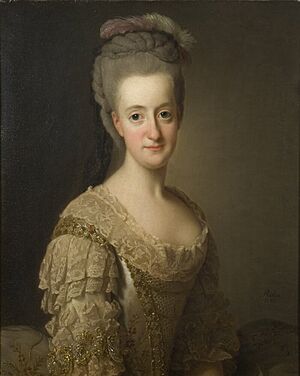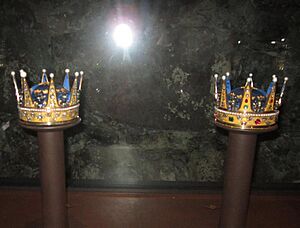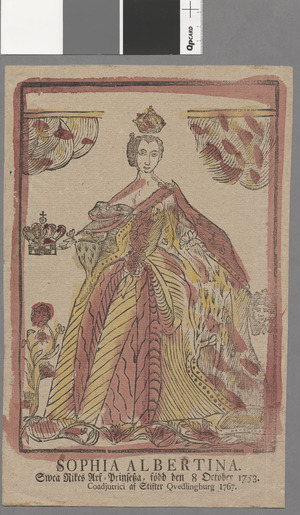Sophia Albertina, Abbess of Quedlinburg facts for kids
Quick facts for kids Sophia Albertina |
|||||
|---|---|---|---|---|---|

Portrait by Alexander Roslin, c. 1775
|
|||||
| Princess-Abbess of Quedlinburg | |||||
| Reign | 1787–1803 | ||||
| Predecessor | Anna Amalia | ||||
| Born | 8 October 1753 Stockholm, Sweden |
||||
| Died | 17 March 1829 (aged 75) Stockholm |
||||
| Burial | Riddarholmen Church | ||||
| Issue | Ulla Möllersvärd (rumored) | ||||
|
|||||
| House | Holstein-Gottorp | ||||
| Father | Adolf Frederick of Sweden | ||||
| Mother | Louisa Ulrika of Prussia | ||||
| Religion | Lutheran | ||||
Princess Sophia Albertina of Sweden (born October 8, 1753 – died March 17, 1829) was a Swedish princess. Her full name was Sophia Maria Lovisa Fredrika Albertina. She was the last Princess-Abbess of Quedlinburg Abbey. This meant she ruled a small state within the Holy Roman Empire.
Sophia Albertina was the daughter of King Adolf Frederick of Sweden and Queen Louisa Ulrika of Prussia. She was a princess of Sweden and a princess of Holstein-Gottorp. She was also the sister of King Gustav III of Sweden. Later in her life, when her brother Charles XIII of Sweden became king of Norway, Sophia Albertina did not become a Norwegian royal. She was then officially called "Royal Princess" (without a country).
She was named after her two grandmothers. These were Queen Sophia Dorothea of Hanover from Prussia and Margravine Albertina Frederica of Baden-Durlach.
Contents
Biography
Early Life and Education
Sophia Albertina had several teachers and governesses. Baroness Ulrica Schönström and Countess Magdalena Stenbock were among those who supervised her. She learned French, dance, drawing, and music. Her mother, Queen Louisa Ulrika, might not have wanted her to marry. This is because she arranged a special position for Sophia Albertina at Quedlinburg Abbey when she was only 14.
Sophia Albertina lived at her mother's court. She was very close to her youngest brother, Prince Frederick Adolf of Sweden. They were both their mother's favorites. She stayed under her mother's strict control until her mother passed away in 1782.
Life at the Swedish Court
Sophia Albertina was known for enjoying parties. She loved the fun events at the court of her brother, King Gustav III. People described her as kind-hearted but also very strong-willed. She was generous and caring, but could easily get into arguments.
She often stood up for women she felt were treated unfairly. For example, she spoke up when King Gustav III was too harsh on ladies acting in his plays. She also helped Magdalena Rudenschöld during a difficult time. She managed to get Magdalena's death sentence changed.
In 1789, during a special meeting of the Swedish parliament (Riksdag), Sophia Albertina was present. She watched the sessions from a hidden window. She supported her brothers when they disagreed with the King's new law, the Union and Security Act. This law gave the King more power. Many noblewomen showed their protest by not attending the King's court events. Instead, they visited Sophia Albertina and her sister-in-law, Hedvig Elisabeth Charlotte. The King was not happy about this. He even accused Sophia Albertina of leading this protest.
Sophia Albertina loved theatre and dance. She also enjoyed riding horses and hunting. She had many pet dogs, at least thirteen! She was also an artist. She painted portraits and funny drawings. In 1793, she became a member of the Accademia di San Luca in Rome.
The Lolotte Forssberg Story
In 1795, a surprising event happened involving Sophia Albertina's maid, Lolotte Forssberg. Sophia Albertina received an anonymous letter. It claimed that Lolotte Forssberg was her secret sister. Sophia Albertina investigated and believed the story. She decided to treat Lolotte as her sister. This caused a big stir in Sweden and Germany.
It is now thought that Lolotte Forssberg was Sophia Albertina's half-sister. This means they shared the same father, King Adolf Frederick. In 1799, Sophia Albertina herself said that Lolotte was her illegitimate half-sister. She arranged for Lolotte to marry a courtier and be presented at court. Lolotte Forssberg stayed with Sophia Albertina for her whole life. Sophia Albertina even named her as an heir in her will.
Ruling as Princess-Abbess
In 1767, Sophia Albertina was given a special role at Quedlinburg Abbey. This was a convent for Lutheran women. Her uncle, Frederick the Great of Prussia, helped her get this position.
In 1787, she became the Princess-Abbess of Quedlinburg. She took over from her aunt, Anna Amalia. As Princess-Abbess, she was the ruler of a small German state. This made her a monarch within the Holy Roman Empire.
When she became abbess, Frederick the Great offered to buy Quedlinburg and add it to Prussia. Sophia Albertina refused. She traveled to Quedlinburg in 1787 and took her oath.
Her rule as Princess-Abbess was very popular. She started schools for poor children. She also created the first theatre in the city. She even increased the pay for the clergy (church leaders). She visited Quedlinburg several times between 1787 and 1803. She managed the state with her chancellor, Sebastian von Moltzer.
In 1803, the state of Quedlinburg was taken over by Prussia. This happened after a peace treaty allowed German rulers to take over church states. Sophia Albertina was told that her state was now part of Prussia. She lost all her political power. However, she was allowed to keep her title and income for the rest of her life. She stayed in Quedlinburg until September 1803.
Later Years
After Quedlinburg Abbey was dissolved, Sophia Albertina stayed in Sweden. In 1807, she lost her income from Quedlinburg. This happened when it became part of the new Kingdom of Westphalia. She wrote to Napoleon for help, but got no reply.
During the Coup of 1809, her nephew King Gustaf IV Adolf was removed from power. Sophia Albertina did not leave with him. When the new leaders entered Stockholm, she greeted them from her balcony. She then attended the coronation of her brother, who became King Charles XIII.
She was not very close to the new heir to the throne, Charles August of Augustenburg. However, she was very fond of the next chosen heir, Charles John Bernadotte. Charles John tried hard to show his affection for her. He wanted to gain public support.
After her sister-in-law passed away in 1818, Sophia Albertina became the first lady of the royal court. She held this role until 1823. That year, Charles John's wife, Désirée Clary, returned to Sweden. In 1819, Sophia Albertina started a charity group called Välgörande fruntimmerssällskapet.
In her final years, she spent a lot of time with the Crown Prince couple. She was the last member of the old royal family. King Charles XIV John wanted her to be at all official events. This helped him make his new royal family seem more legitimate. At the Crown Prince's wedding in 1823, she placed the bridal crown on the bride's head. In 1826, she was present at the birth of the future King Charles XV of Sweden. She had the important job of telling the King about the birth and the baby's gender. She continued to attend royal ceremonies until her death. She was often called the "Vasa Princess."
Legacy
The main church in Landskrona, Sofia Albertina Church, is named after her. It opened in 1788.




